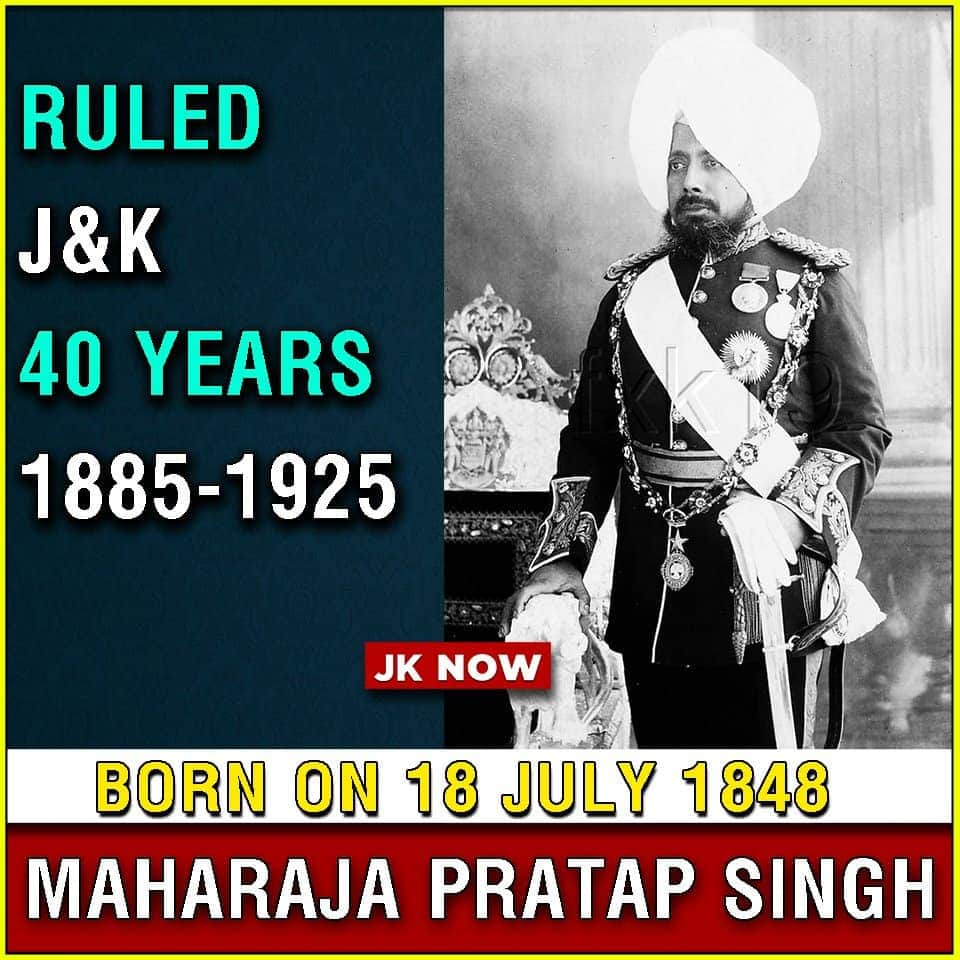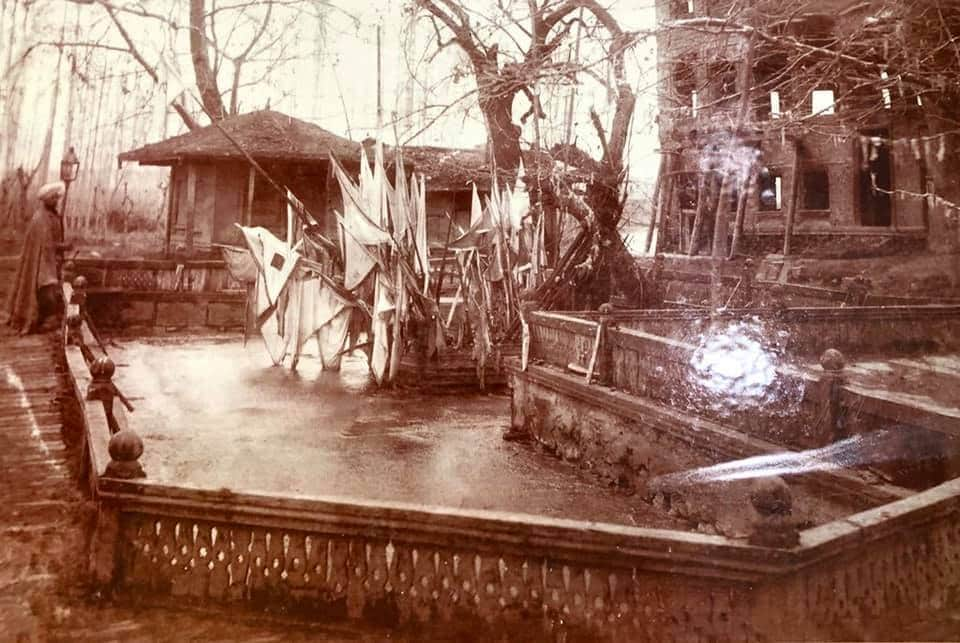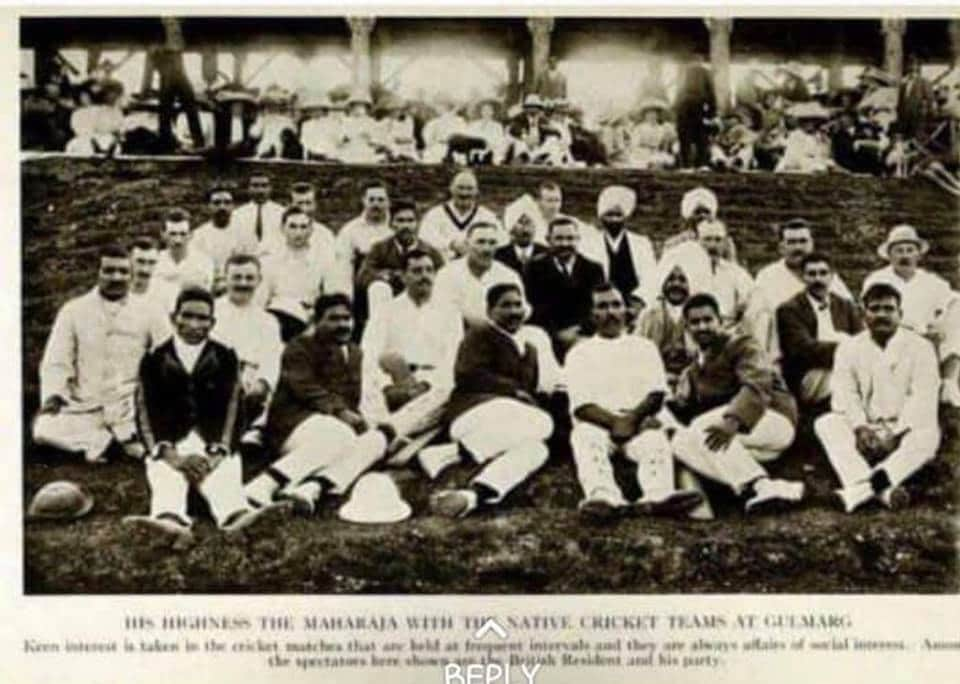Tribute to Maharaja Sir Pratap Singh GCSI GCIE GBE on his birth anniversary. His 40 year reign was longest among Dogra rulers of Jammu & Kashmir (1885-1925) that saw many development and social welfare measures. He was widely respected by all sections of society across the state.
An informative article by Col. J.P. Singh highlighting contributions of Maharaja Pratap Singh in developing Jammu and Kashmir :-
Maharaja who transformed Kashmir
Maharaja Pratap Singh, the third Dogra ruler, ruled Jammu & Kashmir for 40 years from 1885 to 1925, the longest of
Maharaja who transformed Kashmir
Maharaja Pratap Singh, the third Dogra ruler, ruled Jammu & Kashmir for 40 years from 1885 to 1925, the longest of
the all the Dogra emperors. He was very generous by nature, a moderniser and a visionary. Out of the four Dogra rulers, Maharaja Pratap Singh’s era was a period of enlightenment for his subjects, particularly for Kashmiris. He did a lot towards establishing local self governing
bodies, democratic processes, educational systems, health care & hygiene and infrastructure development during his rule.
Since born at Reasi, he is remembered in Reasi by General Zorawar Singh Memorial Committee on his annual birth anniversaries.
Soon after his coronation he
Since born at Reasi, he is remembered in Reasi by General Zorawar Singh Memorial Committee on his annual birth anniversaries.
Soon after his coronation he
had to endure and agonize over the personal humiliation meted out to him by a diplomatic ‘coup-de-grace’ engineered by the British blaming him of hobnobbing with Russians against British, which abolished his authority. Eventually nothing was proved against him.
 Despite British apathy, Jhelum Valley Cart road, a wonderful mountain road of world, starting from Kohala to Baramulla was completed in 1889.
Despite British apathy, Jhelum Valley Cart road, a wonderful mountain road of world, starting from Kohala to Baramulla was completed in 1889.This was 1st major initiative in road connectivity. In 1897, was extended to Srinagar. Thereafter another highway, Bannihal Cart Road,
connecting Jammu with Srinagar was thrown open to the public in 1922. Besides these highways, many other roads & tracks connecting Srinagar to Gilgit and Leh & many other places were completed. The benefits of these roads on general public may be judged form the fact that before
Maharaja Pratap Singh’s reign, there wasn’t any Tonga/Bael Gari (wheeled conveyance), nor even a hand driven cart seen in the state.
By the time his rule ended, large boats, B class buses and trucks (motor vehicles) became the principal means of conveyance and transportation.
By the time his rule ended, large boats, B class buses and trucks (motor vehicles) became the principal means of conveyance and transportation.
 Dept of Agriculture and Cooperative Societies were the other initiatives taken to further improve the lot of farmers and cultivators.
Dept of Agriculture and Cooperative Societies were the other initiatives taken to further improve the lot of farmers and cultivators.In 1887, Maharaja ordered land settlement. As a result, the rights of the agriculturists were clearly defined. The share of agriculture produce
for the state was fixed at 1/3rd of the gross produce. Revenue was collected in cash.
The land settlement gave much needed security to the cultivators and became responsible for increased productivity and increasing prosperity. The revenue of the state more than doubled.
The land settlement gave much needed security to the cultivators and became responsible for increased productivity and increasing prosperity. The revenue of the state more than doubled.
 Lot of stress was laid to popularise education. Number of boys and girls schools and hostels were opened. Primary education was made free. Grants for education were budgeted. One degree college each at Srinagar and Jammu were opened.
Lot of stress was laid to popularise education. Number of boys and girls schools and hostels were opened. Primary education was made free. Grants for education were budgeted. One degree college each at Srinagar and Jammu were opened.
By 1938, Sri Pratap College, with 1187 students was adjudged being the second largest college affiliated to Panjab University. 69 years of independence we are still grappling with providing quality education to the youths of our state.
 Real drive in modernisation of health care occurred during Maharaja Pratap Singh era. Kashmir Mission Hospital was expanded which soon became a hub of health care activities. In 1889, in two largest cities of J&K, Jammu & Srinagar, two govt Hospitals were commissioned.
Real drive in modernisation of health care occurred during Maharaja Pratap Singh era. Kashmir Mission Hospital was expanded which soon became a hub of health care activities. In 1889, in two largest cities of J&K, Jammu & Srinagar, two govt Hospitals were commissioned.
In other towns and important villages, dispensaries were started under qualified doctors. These initiatives went a long way in improving health of people.
Smallpox used to take a very heavy toll of life in valley. Large scale vaccinations were administered in 1894 to prevent it.
Smallpox used to take a very heavy toll of life in valley. Large scale vaccinations were administered in 1894 to prevent it.
 To prevent floods in Srinagar a wide spill channel was constructed in 1904 which diverted the flood waters of Jhelum.
To prevent floods in Srinagar a wide spill channel was constructed in 1904 which diverted the flood waters of Jhelum.Several irrigation canals were constructed in Jammu and Kashmir.
The longest and important of these is Ranbir Canal in Jammu with a total length of 251 miles
including its tributaries. It was completed in 1911 and cost Rs. 35,36,714.
This Canal also helped in propelling the turbines of the Jammu hydro-electric stations.
Besides agriculture; sericulture, viticulture and horticulture were made into flourishing industries.
This Canal also helped in propelling the turbines of the Jammu hydro-electric stations.
Besides agriculture; sericulture, viticulture and horticulture were made into flourishing industries.

1st pic: Seen here with his brother Raja Amar Singh Ji (Chief of Jammu & Kashmir Army) performing Puja at Chandanwari during Amarnath Yatra, 1898.

2nd pic: A rare and old photograph of the sacred spring of Mata Kheer Bhawani in Tulmulla, Srinagar.

More Information about 2nd pic - The old temple & ruins of the shrine found beneath were rebuilt by Maharaja Pratap Singh in the early 1900’s.
 Maharaja Pratap Singh with his state Jammu Kashmir’s cricket team along with the British Resident and party.
Maharaja Pratap Singh with his state Jammu Kashmir’s cricket team along with the British Resident and party.
Cricket team at Gulmarg
 Maharaja Pratap Singh with his state Jammu Kashmir’s cricket team along with the British Resident and party.
Maharaja Pratap Singh with his state Jammu Kashmir’s cricket team along with the British Resident and party.Cricket team at Gulmarg
Maharaja Pratap Singh, born on 18 July 1848, (corresponding to Samvat 1st Sawan 1905), left for heavenly abode on 23 September 1925 at the age of 77 having ruled the longest and done a great deal for his subjects.
A great Maharaja who ruled state with the Tapo-Tej. A question before us today is are we justified in forgetting an iconic ruler?
Since he had no heir of his own, his nephew Maharaja Hari Singh Ji, the ruler-in-waiting, took over the reigns of the dominion on 24 September 1925.
Since he had no heir of his own, his nephew Maharaja Hari Singh Ji, the ruler-in-waiting, took over the reigns of the dominion on 24 September 1925.

 Read on Twitter
Read on Twitter



